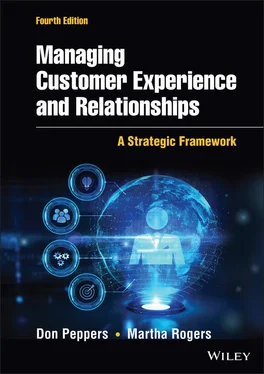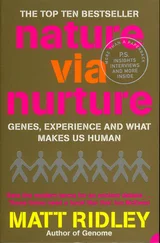1 ...7 8 9 11 12 13 ...30 The overall business goal of this strategy is to make the enterprise as profitable as possible over time by taking steps to increase the value of the customer base.
A suite of buzzwords have come to surround this endeavor, in addition to customer relationship management (CRM): one-to-one marketing, customer experience management, customer value management,customer focus, customer orientation,customer centricity, customer experience journey mapping,and more.
You can see it in the titles on the business cards—chief marketing officer, of course, but also a host of others, such as:
Customer success manager (B2B)
Chief customer officer (B2C)
Chief relationship officer
Customer care leader
Customer experience manager
Customer experience advocate
Director, customer experience and digital design
Customer value management director
Chief revenue officer
Customer revolutionary
As with all new initiatives, this customer approach (different from the strictly financial approach or product-profitability approach of the previous century) suffers when it is poorly understood, improperly applied, and incorrectly measured and managed. But by any name, strategies designed to build the value of the customer base by building relationships with one customer at a time, or with well-defined groups of identifiable customers, are by no means ephemeral trends or fads any more than computers or connectivity are.
A good example of a business offering that benefits from individual customer relationships can be seen in online banking services, in which a consumer spends several hours, usually spread over several sessions, setting up an online account and inputting payee addresses and account numbers, in order to be able to pay bills electronically each month. If a competitor opens a branch in town offering slightly lower checking fees or higher savings rates, this consumer is unlikely to switch banks. They have invested time and energy in a relationship with the first bank, and it is simply more convenient to remain loyal to the first bank than to teach the second bank how to serve them in the same way. In this example, it should also be noted that the bank now has increased the value of the customer to the bank and has simultaneously reduced the cost of serving the customer, as it costs the bank less to serve a customer online than at the teller window or by phone.
Clearly, customer strategy involves much more than marketing, and it cannot deliver optimum return on investment of money or customers without integrating individual customer information into every corporate function, from customer service to production, logistics, and channel management. A formal change in the organizational structure usually is necessary to become an enterprise focused on growing customer value. As this book shows, customer strategy is both an operational and an analytical process. Operational CRMfocuses on the software installations and the changes in process affecting the day-to-day operations of a firm—operations that will produce and deliver different treatments to different customers. Analytical CRMfocuses on the strategic planning needed to build customer value as well as the cultural, measurement, and organizational changes required to implement that strategy successfully.
How to Think About Relationships and Customer Experience as Key to Business Strategy
The move to a customer-strategy business modelhas come of age at a critical juncture in business history, when managers are deeply concerned about declining customer loyalty as a result of greater transparency and universal access to information, declining trust in many large institutions and most businesses, and increasing choices for customers. As customer loyalty decreases, profit margins decline, too, because the most frequently used customer acquisition tactic is price cutting. Enterprises are facing a radically different competitive landscape as the information about their customers is becoming more plentiful and as the customers themselves are demanding more interactions with companies and creating more connections with each other. Thus, a coordinated effort to get, keep, and grow valuable customers has taken on a greater and far more relevant role in forging a successful long-term, profitable business strategy.
If the last quarter of the twentieth century heralded the dawn of a new competitive arena, in which commoditized products and services have become less reliable as the source for business profitability and success, it is the new computer technologies and applications that have arisen that assist companies in managing their interactions with customers. These technologies have spawned enterprise-wide information systems that help to harness information about customers, analyze the information, and use the data to serve customers better. Technologies such as enterprise resource planning (ERP) systems, supply chainmanagement (SCM) software, enterprise application integration (EAI) software, data warehousing, sales force automation (SFA),marketing resource management (MRM), and a host of other enterprise software applications have helped companies to mass-customizetheir products and services, literally delivering individually configured communications, products, or services to unique customers in response to their individual feedback and specifications.
The accessibility of the new technologies is motivating enterprises to reconsider how they develop and manage customer relationships and map the customer experience journey. More and more chief executive officers (CEOs) of leading enterprises have identified shifting to a customer-strategy business model as a top business priority for the 21st century. Technology is making it possible for enterprises to conduct business at an intimate, individual customer level. Indeed, technology is driving the shift. Computers can enable enterprises to remember individual customer needsand estimate the future potential revenue the customer will bring to the enterprise. What's clear is that technology is the enabler; it's the tail , and the one-to-one customer relationship is the dog .
Traditional Marketing Redux
Historically, traditional marketing efforts have centered on the four Ps— product, price, promotional activity, and place—popularized by marketing experts E. Jerome McCarthy aand Philip Kotler. bThese efforts have been enhanced by our greater (and deeper) understanding of consumer behavior, organizational behavior, market research, segmentation, and targeting. In other words, using traditional sampling and aggregate data, a broad understanding of the market has preceded the application of the four Ps, which enterprises have deployed in their marketing strategy to bring uniform products and services to the mass market for decades. cIn essence, the four Ps are all about the “get” part of “get, keep, and grow customers.” These terms have been the focal point for building market share and driving sales of products and services to consumers. The customer needed to believe that the enterprise's offerings would be superior in delivering the “four Cs”: customer value, lower costs, better convenience, and better communication. dMarketing strategies have revolved around targeting broadly defined market segmentsthrough heavy doses of advertising and promotion.
This approach first began to take shape in the 1950s. Fast-growing living standards and equally fast-rising consumer demand made organizations aware of the effectiveness of a supply-driven marketing strategy. By approaching the market on the strength of the organization's specific abilities, and creating a product supply in accordance with those abilities, it was possible for the firm to control and guide the sales process. Central to the strategic choices taken in the area of marketing were the—now traditional—marketing instruments of product, price, place, and promotion—the same instruments that served as the foundation for Philip Kotler's theory and the same instruments that still assume an important role in marketing and customer relations today.
Читать дальше












